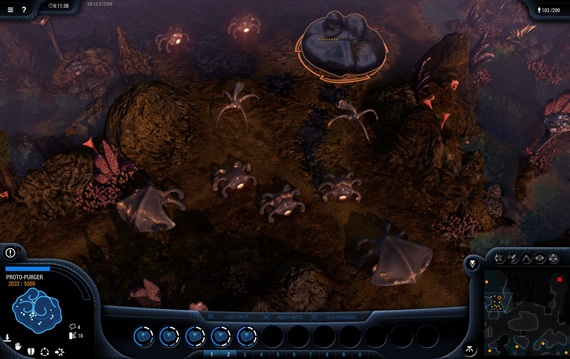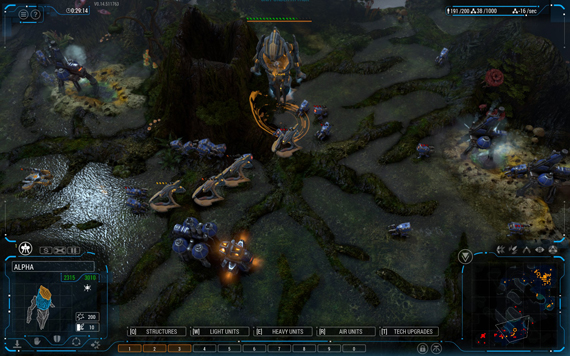
I recently had the opportunity to preview Petroglyph’s upcoming real time strategy title Grey Goo. The game is inspired by the hypothetical doomsday scenario of the same name, whereby self-replicating molecular machines consume all matter on Earth in order to fuel their endless reproductive cycle.
Replicated here is the usual model that sees three opposing species pitted against each other, each with a unique set of features designed to alter the gameplay paradigm of a particular race.
When it comes to RTS my approach is somewhat religious. That is to say, I am possessed of a fanatical devotion to one particular entity (in this case, StarCraft) and denounce all others. Grey Goo was immediately familiar in a superficial sense, but quickly distinguished itself with a number of unique spins on the format–and, interestingly, a focus on macro gameplay.

The three races featured are the alien Beta, the futuristic Humans, and finally the eponymous Grey Goo. The Beta and Humans are largely comparable, though they feature unique conventions for base building. The Beta can drop power hubs anywhere they possess sight, and then construct structures attached to those hubs–giving them the ability to expand quickly.
Meanwhile, Humans are built around a similar power-based mechanic, except every structure on the field must be connected via power lines. These lines make expansion more difficult, but the humans are bolstered by the ability to create a variety of defensive structures that outstrip those of the Beta. Thusly, the Humans excel at turtling and protecting what they own.

After familiarizing myself with the Humans and Beta, I felt I had a reasonable grasp on the trappings of this title–and was completely unprepared for the curve ball thrown by the title race, the Grey Goo. The molecular machine species eschews traditional base building, in that they build absolutely no structures.
They play, quite impressively, exactly the way one might expect from the concept. Rather than constructing a series of buildings with unique functions, everything the Goo produces comes from the Mother Goo. This large blob of nano machines is free moving (and can even attack enemy units and structures by engulfing and consuming them) and increases its mass by sitting atop resource vents and absorbing the energy and matter contained within.
Upon reaching various mass tiers, the Mother Goo can undergo divisions, with the resulting smaller blobs then reformatting themselves into specialized units–such as a tank or scout. The Mother Goo can even create an additional Mother Goo to establish an expansion, or morph into a massive Purger unit, which breaks enemy bases and obliterates opposing units.
Since even a single Mother Goo can quickly establish a new resource flow and unit production line, the Goo enjoy formidable adaptability. Their extreme flexibility is countered by their relative vulnerability; unlike the other races, they have no defensive structures and their lack of a traditional base makes them easy to harass and push back when territory is contested.

Some other interesting mechanics notably spin the gameplay in a unique direction. Foremost among this is the inclusion of brush, which acts much like the jungle in Dota—units concealed within brush can fire at enemies outside of it, but enemies outside cannot fire into the brush without first gaining sight. This also applies to air units—meaning a ground unit must have vision inside the brush for bombers to root out enemy forces within.
Also of note is that air units for the humans and Beta carry limited armaments and must re-arm at hangars, adding an entirely new dimension to achieving air superiority. Air units (and the platforms they require) must be carefully guarded while vulnerable, but are formidable when fully armed. Additionally, several systems exist for removing the burden of micromanagement from the player—such as the ability to assign automated unit production to structures—and even resource management is handled largely by the game itself, which conveniently informs the player what their net resource gain (or loss) per second is at any given time.

Included in the preview build were the first three campaign missions, in which the Beta find themselves attacked by the mysterious humans—presumably over the resource called “catalyst” that fuels each faction. The missions themselves are fairly straightforward; there isn’t a lot happening beside basic objectives. While the production values surrounding the campaign are high (with some fantastic cutscenes and mission briefs) and the tease of the story is enough to garner interest, the early missions perhaps don’t do enough to quickly establish what makes the game unique. When the retail version drops, however, there should be plenty of room for the campaign to rectify this issue.
Grey Goo drops January 23rd and will feature a single-player campaign, multiplayer matchmaking and a versus-AI skirmish mode. Given the clever, intriguing design of the title, I am excited to see if Grey Goo reaches its full potential upon release.
Petroglyph Games
Publisher
Petroglyph Games
System
Steam PC
Modes
Single-Player, Multiplayer
Release Date
January 23, 2015
Price
TBA
*Beta Access was provided by the publisher for this post
